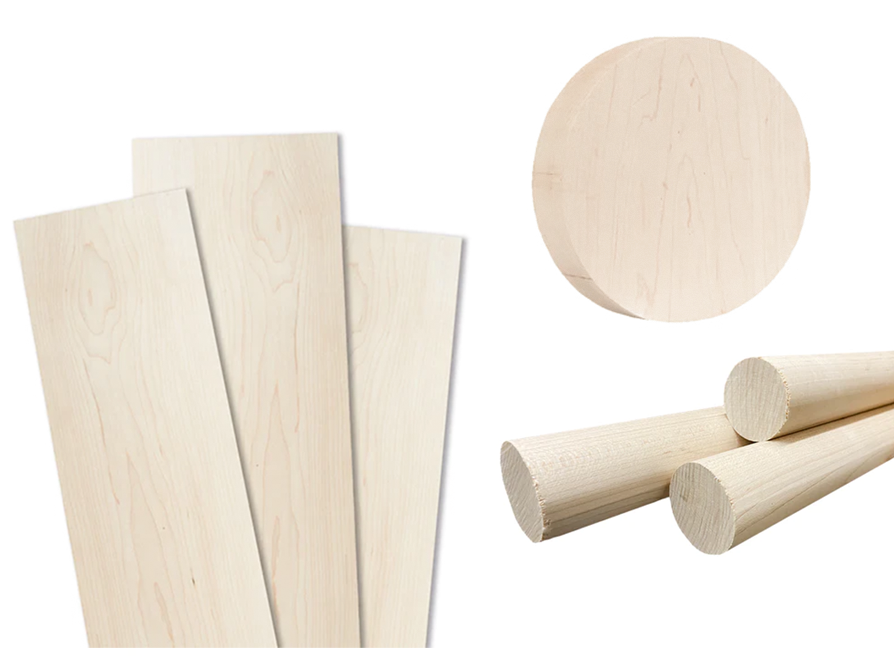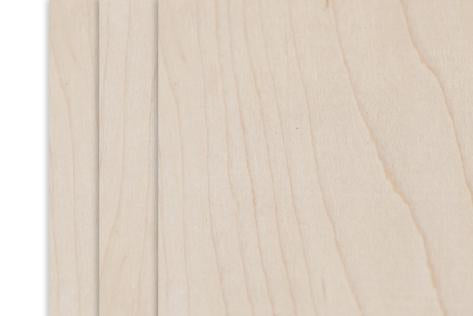Characteristics


Appearance
Maple sapwood typically exhibits colors from white to creamy off-white, characterized by a smooth, uniform grain texture. It showcases a variety of distinctive figures, such as curl, bird's eye, and quilted grain patterns, adding to its aesthetic appeal.
Workability
Maple wood is compatible with machine and hand tools, offering a smooth work experience. Yet, it can be challenging to plane against the grain, and using dull saw blades or router bits may lead to burning.
Uses
Maple lumber is excellent for crafting cutting boards, workbenches, butcher blocks, veneers, musical instruments, baseball bats, and various turned objects, offering durability and versatility across these applications.
Maple Categories
Maple Products
Types of Maple Wood
Maple wood, celebrated for its versatility and beauty, comes in a variety of types, each with unique characteristics and uses. Hard maple, or sugar maple, is known for its strength and density, making it ideal for heavy-duty applications such as furniture and butcher blocks that require durability. Its tight grain and light color offer a classic look that is both timeless and elegant. Soft maple, in contrast, is slightly less dense, which makes it easier to work with for detailed carpentry tasks, including cabinetry and trim. Silver maple, one of the soft maple varieties, is often used in furniture and woodworking projects for its workability and fine texture. Red maple, another soft type, provides a good balance of hardness and workability, making it suitable for a wide range of products, from musical instruments to decorative items.
The highly prized bird's eye maple, whose distinctive pattern resembles tiny, swirling eyes, is sought after for high-end furniture and detailed inlay work. Similarly, curly maple, featuring a wavy grain that creates a three-dimensional effect, adds visual interest and depth to pieces like musical instruments and custom cabinetry. With its luxurious, rippled texture, quilted maple is favored for its dramatic visual impact in artisanal creations. Beyond these are other specialized figures and types of maple wood, each selected for specific attributes that enhance the functionality and natural beauty of the finished products. From the robustness of hard maple to the nuanced patterns of figured maple, this wood type offers a broad spectrum of possibilities for artisans and designers alike. Whether you want structural integrity, aesthetic appeal, or a balance of both, maple wood provides a comprehensive solution that meets a wide array of design and functional requirements. Its diversity not only showcases the adaptability of wood as a material but also highlights the creativity and innovation possible in woodworking and design.

Exploring the Many Applications of Maple Wood
With its remarkable versatility and aesthetic appeal, maple wood is utilized across a broad spectrum of applications, reflecting its widespread popularity in both traditional and contemporary settings. In furniture making, maple's fine grain and ability to accept a variety of finishes allow for a range of styles, from the sleek and modern to the ornate and traditional. The wood's uniform texture and strength are ideal for crafting sturdy and long-lasting workbenches and cutting boards. Maple's resistance to wear makes it perfect for butcher blocks, where its surface can withstand repeated chopping without significant damage. In musical instruments, maple is prized for its excellent sound transmission properties, forming the back, sides, and necks of violins, violas, and guitars, contributing to their rich tones and resonance.
For sports equipment, such as baseball bats, maple wood provides the necessary durability and shock resistance athletes require. The wood's aesthetic qualities are showcased in turned objects and fine decorative items, where its various grain patterns add visual interest and value. Maple veneer is used to cover surfaces, offering the beauty of maple at a reduced cost and weight, making it suitable for:
- Paneling
- Cabinetry
- Furniture
Beyond these common uses, maple wood finds its way into specialty items like custom-made pens and intricate wooden toys, demonstrating its adaptability and appeal. This diversity in applications highlights maple wood's balance of functional and decorative qualities, making it a beloved material among carpenters, woodworkers, and designers. From practical everyday items to intricate artistic creations, maple wood's range of uses is a testament to its enduring appeal and reliability. Its continued popularity underscores its physical qualities and the natural beauty it brings to any project or space.
The Intricacies of Maple Wood Grain
Maple wood is known for its fine and generally straight grain, which lends itself to a smooth and uniform appearance. This characteristic makes it highly desirable for detailed woodworking projects where consistency and quality of finish are paramount. However, maple wood grain can vary, with certain types of maple exhibiting distinctive patterns such as bird's eye, quilted, or curly grain, adding unique visual interest and texture to the wood. These variations in grain pattern enhance the natural beauty of maple wood, making each piece distinct and sought after for high-end furniture and decorative items. Options include:
- Straight Grain: The typical straight grain of maple provides a clean and consistent look, ideal for a wide range of applications, including fine furniture.
- Bird's Eye Grain: This unique pattern features small, circular figures that resemble bird's eyes, adding a rare and decorative element to the wood.
- Curly Grain: Maple with curly grain displays a wavy texture that creates a three-dimensional effect, offering depth and movement to the wood's surface.

Exploring Maple Color
Maple wood is celebrated for its captivating range of colors, from the pale, creamy hues of its sapwood to the richer, deeper tones of its heartwood. The sapwood typically presents a light, nearly white to creamy off-white color, providing a neutral and bright canvas suitable for various finishes and stains. As it ages, maple's color can develop a golden patina, adding warmth and depth to the wood's natural tones. Although less commonly used, the heartwood can exhibit colors from light to medium brown, sometimes with a reddish or golden hue, contributing to the wood's overall aesthetic appeal. This color variation within the maple species allows for flexibility in design and application, making it a favorite among interior designers and furniture makers. The ability of maple to take on a wide range of stains and finishes further amplifies its versatility, making it an ideal choice for crafting pieces that require specific coloration to match interior design schemes.





 114 Reviews
114 ReviewsThe lightest and softest of all commercial woods! Great for model airplanes, fishing lures, musical instruments, and more!
Frequently Asked Questions About Maple Wood
As a leading hardwood provider, KJP Select Hardwoods is a trusted source of information about maple wood. Read the following questions for the answers you need.
Is Maple a Hardwood?
Even though maple is referred to as hard and soft, all the different varieties are classified as hardwood.
Is Maple a Good Wood?
Because of its durability, coloring and grain, maple is an excellent wood for a broad array of applications.
Is Maple an Expensive Wood?
Maple is a highly affordable wood.
Trust KJP Select Hardwoods for All Your Maple Wood Needs
KJP Select Hardwoods has an excellent assortment of maple wood, including rough cut and S4S lumber, thins, and a great mix pack featuring four different types of maple wood. We also offer other options like live edge pieces, bowl blanks and cutting board packs. Explore our outstanding selection today to find the perfect maple wood for your next project.













